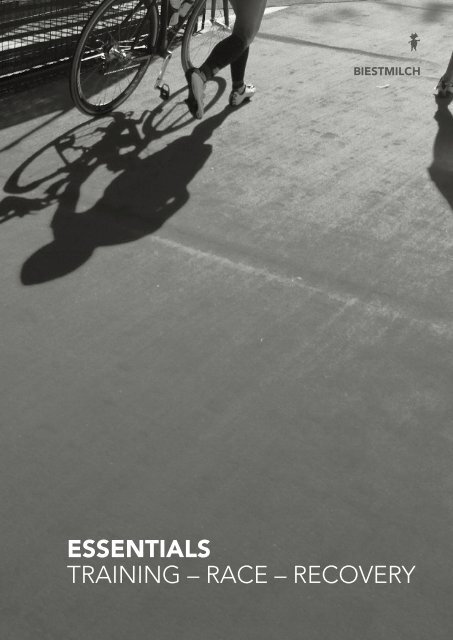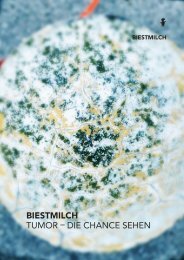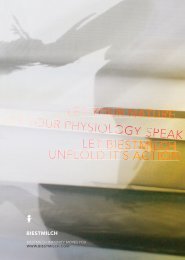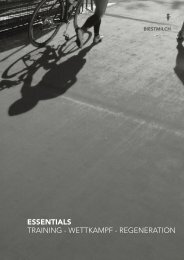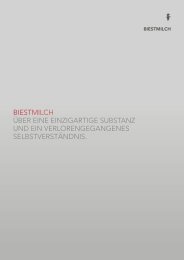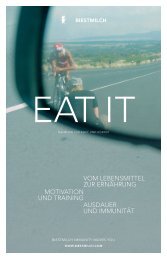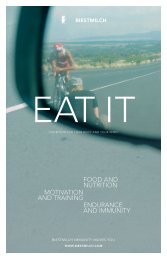Triathlon : Training – Race – Recovery
100% natural bovine colostrum in a special form. BIESTMILCH is all natural and stands for a balanced immunity, more focus, better muscle coordination and a more stable stomach and gut. www.biestmilch.com/store
100% natural bovine colostrum in a special form. BIESTMILCH is all natural and stands for a balanced immunity, more focus, better muscle coordination and a more stable stomach and gut.
www.biestmilch.com/store
Create successful ePaper yourself
Turn your PDF publications into a flip-book with our unique Google optimized e-Paper software.
Biestmilch<br />
ESSENTIALS<br />
<strong>Training</strong> <strong>–</strong> <strong>Race</strong> <strong>–</strong> <strong>Recovery</strong><br />
|<br />
1
The organism only<br />
talks one language.<br />
All elements are<br />
connected in a<br />
multidirectional way.<br />
If you want be able to retrieve your personal best or just to cross the finish line without<br />
struggling too much, your body has to be in robust equilibrium. The following article<br />
picks up the rather vague term of balance and tries to elucidate in brief how balance<br />
can be achieved and maintained. To stay balanced is the secret for keeping yourself<br />
healthy despite strenuous workouts and competitions. Biestmilch can help.<br />
2<br />
BIESTMILCH<br />
<strong>Training</strong> <strong>–</strong> <strong>Race</strong> <strong>–</strong> <strong>Recovery</strong>
BIESTMILCH ESSENTIALS<br />
<strong>Training</strong> <strong>–</strong> <strong>Race</strong> <strong>–</strong> <strong>Recovery</strong><br />
by Dr. Susann Kraeftner<br />
Perceive the world with your body<br />
Before you start browsing through this broshure, just<br />
imagine your body being a densely woven network in<br />
which all elements are communicating. A current of signals<br />
is permanently rushing through our bodies connecting<br />
all the knots (cells, organs, organ systems) with each<br />
other. This very dynamic process is holding together our<br />
bodies and is responsible for keeping the balance.<br />
BIESTMILCH is a physiological cocktail of signal molecules<br />
stabilizing the network connections. During periods<br />
of severe stress signal transmission is either increasing<br />
to an extent that overburdens the control mechanisms,<br />
or the signal transmission comes to a halt with the same<br />
consequences, namely jeopardizing the body‘s balance.<br />
<strong>Training</strong> should always remain within the borders of balance.<br />
The connections between the knots should be<br />
highly dynamic and flexible. If they become rigid, then<br />
the connectivity might break down in certain areas of the<br />
body, where the strain is extra high. <strong>Training</strong> has to increase<br />
the flexibility and stability of the network connections<br />
of the body. This applies to the body as a whole not<br />
only to the muscles and the metabolic pathways. If you<br />
keep these picts in mind, then BIESTMILCH, the science<br />
and the thought concept behind will be easy for you to<br />
understand.<br />
|<br />
3
1 <strong>Training</strong> preps for<br />
your biggest race<br />
The training preps for your biggest race of the year<br />
are hard times. During these weeks of preparations<br />
you have to permanently push the limits without destroying<br />
the continuity of balance. You have to abstain<br />
from a lot of sweet things to receive the reward in the<br />
end. This drives your body into a delicate situation.<br />
For peaking on time a bunch of conditions have to coincide<br />
and emerge a state of harmony. Staying balanced by<br />
pushing the limits at the same time over the long months<br />
of training may be a shaky walk along a thin red line.<br />
As an athlete who has to combine the preps with regular<br />
working hours the task of being optimally prepared is<br />
even more challenging.<br />
Due to the training stress your body is floating in an inflammatory<br />
state of varying degree beyond the normal.<br />
To control this condition and not tilting over the edge<br />
is the tricky part. Don‘t risk your hard work by getting<br />
sick or injured. Sufficient recovery, a reasonable tapering<br />
phase, abstaining from processed foods and considering<br />
BIESTMILCH as a supporter to make your body more robust<br />
and tolerant for strenuous workloads are the pillars<br />
of balance.<br />
Controlling the inflammatory states<br />
in your body is essential for<br />
staying fit and healthy.<br />
Regardless which training program you follow the continuity<br />
of the training is essential. No injuries, no infections,<br />
no bouts of allergy and sufficient recovery times<br />
are the preconditions for a successful build-up. You are<br />
well familiar with the fact that endurance training means<br />
stress for your body, positive in the case of decent overreaching,<br />
negative in the case of overtraining.<br />
The more you push your body to exertion, the more stressed<br />
it gets. The processes that smolder underneath the surface<br />
and are in the end responsible for the frail conditions you<br />
may drift into during the training are systemic inflammations.<br />
The control mechanisms that contain your body‘s inflammatory<br />
states are therefore challenged at all times. If<br />
you manage your training within the limits where the training<br />
stress is not harming your immune system, autonomic<br />
nervous system and/or your hormone regulation, then the<br />
reward will be a body that can endure a lot. If you do otherwise<br />
and drive your body permanently over the edge, then<br />
inflammatory processes may take over and lead your body<br />
into a state of a chronic systemic inflammation.<br />
Then training does become inefficient. You are lacking<br />
the motivation for the workout, the training feels monotonous<br />
and gets on your nerves. You feel permanently<br />
fatigued and stressed, and you may call yourself lucky,<br />
if you don‘t come down with an illness, an injury or the<br />
worst an overtraining syndrome.<br />
BIESTMILCH makes you more stress-resistant<br />
and modulates the inflammatory processes<br />
in your body<br />
You can take BIESTMILCH as a preventive measure and<br />
as a therapeutic agent. As BIESTMILCH is natural food<br />
produced under highest quality parameters, the intake<br />
is totally harmless. You cannot overdose it. You will always<br />
benefit from it, as you do from other quality foods.<br />
BIESTMILCH has anti-inflammatory effects, strengthens<br />
your immune system and balances the activity of your<br />
autonomous nervous system.<br />
As immunity is one essential pillar<br />
of performance BIESTMILCH is<br />
able to stabilize performance and<br />
support recovery.<br />
4<br />
BIESTMILCH<br />
<strong>Training</strong> <strong>–</strong> <strong>Race</strong> <strong>–</strong> <strong>Recovery</strong>
Here are some cues how you can<br />
find out whether you are still<br />
balanced or already over the edge:<br />
Deep and recreative sleep.<br />
No mood swings,<br />
emotionally stable.<br />
Extent and duration of<br />
fatigue within the scope of<br />
your training exertion.<br />
Duration and extent of muscles<br />
soreness not longer than 3 days.<br />
Good appetite, no craving<br />
for sweets, body weight stable or<br />
controlled weight loss respectively.<br />
Normal temperature sensation,<br />
no bouts of sweating in the cold<br />
and no freezing in the heat.<br />
|<br />
5
Be generous in your use of BIESTMILCH<br />
during taper, don‘t risk all the hard work.<br />
Biestmilch supports immunity and the<br />
nervous system with the impact of improving<br />
healing and being preventive when you start<br />
struggling while tapering.<br />
6<br />
BIESTMILCH<br />
<strong>Training</strong> <strong>–</strong> <strong>Race</strong> <strong>–</strong> <strong>Recovery</strong>
2<br />
The tapering phase<br />
Keeping the balance under the<br />
fragile pre-race conditions<br />
For all of you who are competing tapering is a key<br />
element of the physical preparation in the last 2 to 3<br />
weeks up to the race.<br />
Prof. Timothy Noakes, the author of “Waterlogged“ and<br />
“The Lore of Running“ gives the following advice for this<br />
critical period of time: «Once you decide to taper, do<br />
as little training as your mind will allow you, but do that<br />
little at a fast pace!» Tapering needs lots of experience<br />
as it is a very individual thing. It‘s about finding the right<br />
duration of the taper, the right volume, intensity and frequency<br />
of the specific training sessions and about finding<br />
the most suitable pattern of tapering for yourself.<br />
Besides all controversial discussions around this topic<br />
there is an agreement about the fact that the tapering<br />
phase is a very critical part of the preparation period.<br />
The body then is very frail and traveling long distances<br />
adds up negatively to this anyway difficult condition. The<br />
body‘s susceptibility for illnesses and injuries increases<br />
tremendously.<br />
An incomplete recovery that you were dragging from the<br />
intense training to the tapering phase can worsen the<br />
negative effects appearing during taper. During tapering<br />
the activity of the autonomous nervous system and<br />
the immune system should not decrease dramatically because<br />
otherwise the inflammatory conditions in the body<br />
spread and become more severe.<br />
“My very own way of tapering changed<br />
quite a lot since I began with this sport.<br />
The fitter you get the faster the body<br />
tends to recover. But this doesn‘t mean<br />
that my taper periods became shorter,<br />
no they became different.“<br />
Sebastian Kienle,<br />
<strong>Triathlon</strong> World Champion 2014<br />
The high frequency of stimuli imposed during the pre-taper<br />
overload training phase that ensures an optimum of adaptive<br />
effects declines in the taper phase. This slow-down of<br />
the training leads to a drop of the activity state of the autonomous<br />
nervous system and the immune system.<br />
If one does not succeed to taper by maintaining a certain<br />
activity state of these two systems, then it can happen that<br />
the body loses its tension and falls into the “holiday”. It is<br />
common knowledge that illnesses often appear in phases<br />
of relaxation. Instead of the fact that healing is fostered inflammation<br />
thrives. The gateways for stress-related effects<br />
are open. The range of phenomena is broad and ranges<br />
from sleep disturbances, prolonged fatigue, lassitude, pain<br />
symptoms, to infections.<br />
One of the main goals of the recovery during the taper<br />
should be to keep autonomous nervous system activity and<br />
immunity in balance, and not to turn lethargic.<br />
|<br />
7
3 <strong>Race</strong><br />
Peaking on a solid base<br />
In endurance races the body faces mainly two critical<br />
conditions, one is fatigue and the other are gastrointestinal<br />
complications. During a race you meet all kind<br />
of stress factors that can jeopardize your under these<br />
conditions rather fragile balance.<br />
Fatigued connections between<br />
the brain and the muscles<br />
Brain activity and neuromuscular recruitment are interdependent.<br />
During racing your brain has to be fully present<br />
and awake to guarantee optimal muscular recruitment.<br />
When fatigue kicks in, signal control becomes weaker<br />
and weaker. Then storms of signals can reach the muscle<br />
without getting filtered anymore.<br />
<strong>Training</strong><br />
and Tapering:<br />
Chewies<br />
or Capsules<br />
Start<br />
3,85km<br />
This lack of control of the signal transmission from the<br />
brain to the muscle and back may lead to cramps followed<br />
by exertion and finally exhaustion. This fatigue is<br />
located in the central nervous system not in the muscle.<br />
Early morning<br />
Biest booster<br />
Consequently, you need your brain working at full capacity<br />
to retrieve your personal best.<br />
Leaks in the stomach and gut<br />
Endurance performance affects the integrity of the intestinal<br />
barrier. The prolonged strenuous exercise per se,<br />
heat stress, mechanical shearing forces, oxidative burst,<br />
reduced blood flow, too high an intake of carbs or painkillers<br />
such as non-steroidal anti-inflammatory agents are<br />
only a few of the many stress factors that may induce an<br />
integrity loss of the intestinal barrier.<br />
Integrity loss regardless of its cause is associated with<br />
an increased intestinal permeability. Stomach and/or gut<br />
start leaking. The selective absorption of nutrients from<br />
the gut stops. On the other hand bacteria and toxins penetrate<br />
non-selectively into the body‘s interior and harm<br />
its balance. The symptoms you are then bothered by are<br />
cramps, diarrhea, bloating, nausea, vomiting, pains or/<br />
and stomach bleeding.<br />
8<br />
BIESTMILCH<br />
<strong>Training</strong> <strong>–</strong> <strong>Race</strong> <strong>–</strong> <strong>Recovery</strong>
Take a Booster<br />
1/2 or 1 Booster<br />
180km<br />
42,2km<br />
Finish<br />
Booster on<br />
the Bike<br />
1/2 or 1 Booster<br />
Chewies or Capsules<br />
for <strong>Recovery</strong><br />
Here’s some general advice to help you make the first<br />
step in experiencing the power of Biestmilch in training<br />
and racing.<br />
FOR BASIC TRAINING<br />
If you feel fit and well one BIESTMILCH Chewy Tablet<br />
(900 mg Colostrum) a day suffices.<br />
In case of a lactose intolerance and if you like to learn more<br />
check out our website. There you will find experiences of<br />
our loyal users, the basics about Biestmilch and scientific<br />
background information.<br />
www.biestmilch.com<br />
FOR INTENSIVE TRAINING SESSIONS<br />
If you enhance the intensity (volume and strength)<br />
of your training, then you may increase the amount<br />
of Biestmilch by 3 to 4 times of the standard amount<br />
(900 mg). Preferably you take 2 to 3 of your Biestmilch<br />
Chewy Tablets in the morning, and 1 to 3 after the<br />
last training session.<br />
For a race the BIEST BOOSTER is an excellent<br />
option. It contains 4000 mg of Colostrum and 500 mg<br />
Guarana Extract which equals 100 mg of natural<br />
caffeine. BIESTMILCH (Colostrum)strengthens<br />
immunity and makes you more stress-resistant.<br />
Guarana levels increase smoother compared to the<br />
caffeine in coffee and therefore last longer than<br />
coffee, and Guarana is a cognitive enhancer.<br />
|<br />
9
Muscle adaption process<br />
Microlesions<br />
Inflammatory Environment<br />
Catabolic Process<br />
Repair Process<br />
Adaptation of Muscle Fibres<br />
Anabolic Process<br />
BIESTMILCH supports healing and adaptation in a<br />
condition of inflammation: BIESTMILCH works as an<br />
anti-inflammatory agent and the growth factors it<br />
contains influence the cells‘ regeneration. Cell lesions<br />
are manifold after intensive training sessions and races.<br />
BIESTMILCH‘s molecules foster muscle growth and<br />
repair processes within the disrupted mucosal linings<br />
of all outer surfaces be it the gut, the bronchi, or the<br />
stomach etc.<br />
10<br />
BIESTMILCH<br />
<strong>Training</strong> <strong>–</strong> <strong>Race</strong> <strong>–</strong> <strong>Recovery</strong>
4 <strong>Recovery</strong><br />
Healing processes demand a strong<br />
and balanced immunity<br />
<strong>Recovery</strong> - time for build-up,<br />
inflammation control and healing<br />
<strong>Recovery</strong> is the highly active phase for the body buildup.<br />
If you see this part of the training through these<br />
eyes, it may be easier for you to accept taking a rest<br />
without feeling bad. BIESTMILCH as an inflammatory<br />
modulator is a real asset during this time of your training<br />
program.<br />
Muscle injuries cause inflammations<br />
and are the precondition for<br />
muscle adaptation<br />
The immune system is steering the inflammatory and subsequently<br />
the healing processes. An intact immune system<br />
can heal micro-injuries within 3 to 5 days. If micro-injuries<br />
do not heal well, due to a weakened immune system - this<br />
may be for example because of an insufficient recovery<br />
time - then muscle ruptures and injuries to the sinews may<br />
be the result.<br />
Any form of inflammation pays its toll, be it an injury or an<br />
infection, by consuming energy and consequently leading<br />
to a drop in performance. Due to the fact that never<br />
all muscle fibers are activated at once - studies speak of a<br />
maximum of 50% in competitive athletes - the muscle can<br />
tolerate an overload for quite a long time. Different fibers<br />
are activated by a kind of rotary principle.<br />
The pattern of active fibers even changes during one and<br />
the same training cycle. Parts of the muscle can find time<br />
to regenerate, even if the muscle is not given the proper<br />
recovery time.<br />
It is common knowledge that endurance strains always go<br />
hand in hand with micro-injuries in muscles, sinews, connective<br />
tissue and smallest blood vessels. These tiny injuries<br />
are required in order for the muscle to adapt to a<br />
higher performance level. The injuries can affect only muscle<br />
membranes, certain fibers or the whole fiber bundle.<br />
The reasons for these micro-injuries are not only due to<br />
mechanical forces but are also due to a rising and falling<br />
temperature in the tissues, disturbed blood flow, shifting<br />
of the pH, flooding with free oxygen radicals and/<br />
or missing energy supply. The injuries can be as tiny that<br />
you don‘t not even notice them or so bad that long lasting<br />
muscle pains arise (DOMS, delayed onset of muscle<br />
soreness).<br />
Creatinkinases and myoglobin levels above normal are<br />
typical in such cases. All these injuries induce inflammatory<br />
processes in the body regardless of where they may<br />
be located. The initiated inflammatory processes are the<br />
foundation for all healing and adaptation processes that<br />
finally bring about the training effect as desired.<br />
Efficient build-up processes<br />
need the recovery times<br />
<strong>Training</strong> and racing are situations in which degradation<br />
processes prevail. The metabolism becomes consumptive,<br />
the cortisone and catecholamines levels in the<br />
blood increase and the inflammatory components of<br />
the immune system are activated. In contrast recovery is<br />
dominated by build-up processes. Now energy is used<br />
and needed for protein synthesis. The adaptation of the<br />
muscles to achieve a higher level of performance can begin.<br />
Muscle build-up only happens during recovery and<br />
is the actual goal of the workout. You may have a bad<br />
conscience not training, but your body is not lazy, it is<br />
working hard.<br />
|<br />
11
No Endurance sports without biestmilch<br />
Lose Focus<br />
Heavy Legs<br />
12<br />
BIESTMILCH<br />
<strong>Training</strong> <strong>–</strong> <strong>Race</strong> <strong>–</strong> <strong>Recovery</strong>
Cramps<br />
Stomach and Gut<br />
BIESTMILCH is all natural<br />
and stands for a balanced<br />
immunity, more focus,<br />
better muscle coordination<br />
and a more stable stomach<br />
and gut.<br />
|<br />
13
Literature<br />
RT, Ryan AJ, Gisolfi CV: Effect of<br />
IMPrint<br />
running intensity on intestinal per-<br />
BIESTMILCH - COLOSTRUM<br />
meability. J Appl Physiol 82:571-<br />
Biestmilch Seven GmbH<br />
Distribution<br />
576, 1997.<br />
Herderstraße 31<br />
Antonio J et al.: The Effects of<br />
65185 Wiesbaden, Germany<br />
TRIXSTERS GmbH<br />
Bovine Colostrum Supplementation<br />
Korhonen H, Marnila P, Gill HS : Bo-<br />
Herderstraße 31<br />
on Body Composition and Exercise<br />
Performance in Active Men and<br />
Women. Nutrition March 17(3):<br />
243-247, 2001.<br />
vine milk antibodies for health. Br J<br />
Nutr, 84 Suppl 1: S135-46, 2000.<br />
Kuipers H et al.: Effects of Oral<br />
BIESTMILCH USA, LLC<br />
1129 East Shorewood Court<br />
Coeur d‘Alene, ID 83815<br />
United States<br />
65185 Wiesbaden, Germany<br />
Fon +49 (0)611. 97651-0<br />
Fax +49 (0)611. 97651-25<br />
Bovine Colostrum Supplementation<br />
biestmilch@biestmilch.com<br />
Bitzan MM, Gold BD, Philpott DJ,<br />
on Serum Insulin-like Growth Factor<br />
Concept + Text<br />
www.biestmilch.com/store<br />
et al.: Inhibition of Helicobacter<br />
I Levels. Nutritition, 2002.<br />
Dr. Susann Kraeftner<br />
pylori and Helicobacter mustelae<br />
binding to lipid receptors by bovi-<br />
Leppäluoto J, Rasi S, Martikkala<br />
Design<br />
ne colostrum. J Infect Dis, 177(4):<br />
V, Puukka M.: Bovine Colostrum<br />
designrs frankfurt<br />
955-61; April 1998.<br />
Supplementation enhances Physical<br />
www.designrs.de<br />
Performance on Maximal Exercise<br />
Brinkworth G et al.: Colostrum<br />
Tests. Department of Physiology,<br />
Supplementation improves Buffer<br />
University of Oulu, Department of<br />
Capacity, but not Rowing Perfor-<br />
Sports Medicine, 2000.<br />
mance in Elite Female Rowers. Int. J.<br />
Sports Nutrition 2002.<br />
Marchbank T, Davison G, Oakes JR,<br />
Ghatei MA, Patterson M, Moyer MP<br />
Buckley J et al.: Bovine Colostrum<br />
and Playford RJ: The nutriceutical<br />
Supplementation during Endurance<br />
Running <strong>Training</strong> improves <strong>Recovery</strong>,<br />
but not Performance. J. Sci.: Med<br />
Sport 2002.<br />
Burrin D, Shulman R et al.: Porcine<br />
colostrum and milk stimulate<br />
visceral organ and skeletal muscle<br />
protein synthesis in newborn pigs.<br />
J. Nutr. 122: 1205-1213, 1992.<br />
Cesarone R, Belcaro G, MD, Di Renzo<br />
A, et al.: Prevention of influenza<br />
bovine colostrum truncates the<br />
increase in gut permeability caused<br />
by heavy exercise in athletes. Am<br />
J Physiol Gastrointest Liver Physiol<br />
300: G477-G484, 2011.<br />
Mero A, Miikkulainen H et al.: Effects<br />
of bovine colostrum supplementation<br />
on serum IGF-1, IgG, hormone, and<br />
saliva IgA during training. J. Appl.<br />
Physiol. 83: 1144-1151, 1997.<br />
Mero A et al.: Effects of Pastilles<br />
Seifert J, Molkewehrum M, Oesser<br />
S, et al.:Endotoxin inactivation<br />
by enterally applied colostrum of<br />
different compostion. Eur Surg Res,<br />
34: 68-72, Jan-Apr. 2002.<br />
Shing CM, Jenkins DG et al.:<br />
School of Human Movement<br />
Studies, University of Queensland<br />
and Centre for Phytochemistry and<br />
Pharmacology, Southern Cross University,<br />
Lismore, Australia, 2006.<br />
Inflammation<br />
Adcock IM, Caramori G: Crosstalk<br />
between pro-inflammatory<br />
transcription factors and glucocorticoids.<br />
Immunology and Cell<br />
Biology, Vol.79, No.4, August 2001<br />
Blablock JE: Harnessing a neuralimmune<br />
circuit to control inflammation<br />
and shock. J. Exp. Med. 195:<br />
F25-F28, 2003<br />
episodes with colostrum compared<br />
with vaccination in healthy and highhisk<br />
cardiovascular cubjects: The<br />
Epidemiologic Study in San Valentino.<br />
Department of Biomedical Sciences,<br />
G d‘Annunzio Chieti-Pescara,<br />
Pescara, Italy. Clin Appl Thromb<br />
Hemost, 13: 130-136, 2007<br />
Coombes J et al.: Dose effects of<br />
Oral Bovine Colostrum on Physical<br />
Work Capacity in Cyclists. Med. Sci.<br />
in Spor. & Exer., 2002.<br />
Graczyk TK, Cranfield MR, Bostwick<br />
EF: Hyperimmune bovine colostrum<br />
Containing Bovine Colostrum on<br />
Health of Athletes. XXVIth FIMS<br />
World Congress of Sports Medicine,<br />
Orlando, Florida, p. 34, 1998.<br />
Pacyna J, Siwek K, Terry SJ, et al.:<br />
Survival of rotavirus antibody activity<br />
derived from bovine colostrum<br />
after passage through the human<br />
gastrointestinal tract. Pediatr Gastroenterol<br />
Nutr; 32 (2): 162-7, 2001.<br />
Sarker SA, Caswall TH, Mahalanabis<br />
D, et al.: Successful treatment of<br />
rotavirus diarrhea in children with<br />
immunoglobulin from immunized<br />
Tollemar J, Gross N, Jarstrand C, et<br />
al.: Fungal prophylaxis by reduction<br />
of fungal colonization by oral administration<br />
of bovine anti-Candida antibodies<br />
in bone marrow transplant<br />
recipients. Bone Marrow Transplant,<br />
23(3):283-90; Feb 1999.<br />
Vesa TH, Marteau Ph, Kopela R:<br />
Lactose Intolerance. Journal of the<br />
American College of Nutrition 19<br />
(2), 165-175, 2000.<br />
Brogden KA, Guthmiller JM, SalzetM,<br />
et al: The nervous system and<br />
innate immunity: the neuropeptide<br />
connection. Nature immunology,<br />
6(6): 558-564, 2005<br />
Campo JV, Bridge J, Ehmann M, et<br />
al: Recurrent abdominal pain, anxiety,<br />
and depression in primary care.<br />
Pediatrics, Vol. 113, 4: 817-824, 2004<br />
Delvaux M: Functional bowel disorders<br />
and irritable bowel syndrome<br />
in Europe. Aliment. Pharmacol.<br />
Ther., 18 (Suppl 3): 75-79, 2003<br />
treatment of moribund Leopard<br />
geckos infected with Cryptosporidium<br />
sp. Vet Res, 30(4): 377-382,<br />
Jul-Aug 1999.<br />
Hofman Z et al.: The Effects of<br />
Bovine Colostrum on Excercise<br />
Performance in Elite Field Hockey<br />
Players. Int. J. Sports Nutr, 2002.<br />
Kay L. Pals KL, Ray-Tai Chang<br />
bovine colostrum. Pediatr Infect Dis<br />
J; 17(12): 1149-54, 1998.<br />
Schmidtbleicher D et al.: Effect of<br />
Colostrum on Maximum Strength of<br />
the Skeletal Muscle <strong>–</strong> Results of a<br />
Double-Blind Cross-Over Study over<br />
Several Weeks. Johann Wolfgang<br />
Goethe University, Institute of Sport<br />
Science 2001.<br />
Di Lorenzo C, Benninga MA, Forbes<br />
D, et al: Functional gastrointestinal<br />
disorders, gastrooesophgeal<br />
reflux and neurogastroenterology:<br />
Working Group Report of the<br />
second world congress of pediatric<br />
gastroenterology, hepatology, and<br />
nutrition. J. of Ped. Gastroenterology<br />
and Nutrition, 39: 616-625, 2004<br />
14<br />
BIESTMILCH<br />
<strong>Training</strong> <strong>–</strong> <strong>Race</strong> <strong>–</strong> <strong>Recovery</strong>
Goehler LE, Gaykema RPA, Nguyen<br />
KT, et al: Interleukin-1beta in<br />
immune cells of the abdominal<br />
vagus nerve: a link between the<br />
immune and the nervous system.<br />
The Journal of Neuroscience, 19(7):<br />
2799-2806, 1999<br />
Gundy D, Schemann M: Enteric<br />
nervous system. Current Opinion<br />
in Gastroenterology, 21: 176-182,<br />
2005<br />
Konsman JP, Parnet P, Dantzer R:<br />
Cytokine-induced sickness behaviour:<br />
mechanisms and implications.<br />
Trends in Neuroscience, 23: 154-<br />
159, 2002<br />
Lomax AE, Fernandez E, Sharkey<br />
KA : Plasticity of the enteric<br />
nervous system during interstinal<br />
inflammation. Neurogastroenterologic<br />
Motility, 17: 4-15, 2004<br />
Padgett DA, Glaser R: How stress<br />
influences the immune response.<br />
Trends in Immunology, Vol.24 No.8,<br />
August 2003<br />
Pavlov VA, Tracey KJ: Neural regulators<br />
of innate immune response<br />
and inflammation. Cell. Mol. Life<br />
Sci. 61: 2322-2331, 2004<br />
Rasquin-Weber A, Hyman PE, Cucchiara<br />
S, et al: Childhood functional<br />
gastrointestinal disorders.Gut, 45<br />
(Suppl II): II60-II68, 1999<br />
Sapolsky RM, Romero M, Munck<br />
AU: How Do Glucocorticoids Influence<br />
Stress Responses Integrative<br />
Permissive, Suppressive, Stimulatory<br />
and Preparative Actions.Endocrine<br />
Reviews, 21(1):55-89, 2000<br />
Tracey KJ: The inflammatory reflex.<br />
Nature, Dec. 19/26, 420: 853-859,<br />
2002<br />
Wood JD: Enteric neuroimmunophysiology<br />
and pathophysiology.<br />
Gastroenterology, 127: 635-657,<br />
2004<br />
Gundy D, Schemann M: Enteric<br />
nervous system. Current Opinion<br />
in Gastroenterology, 21: 176-182,<br />
2005<br />
Lomax AE, Fernandez E, Sharkey<br />
KA : Plasticity of the enteric nervous<br />
system during interstinal inflammation.<br />
Neurogastroenterologic Motility,<br />
17: 4-15, 2004<br />
Wood JD: Enteric neuroimmunophysiology<br />
and pathophysiology.<br />
Gastroenterology, 127: 635-657,<br />
2004<br />
Alvami A, Koszinowski UH: viral<br />
mechanisms of immune evasion.<br />
Trends in Immunology, 9: 447-453,<br />
200<br />
Bell JK, Mullen GED, Leifer AC,<br />
et al.: Leucin-rich repeats and<br />
pathogen recognition in Toll-like<br />
receptors. Trend in Immunology,<br />
24: 528-533, 2003<br />
Berger T: Die Zukunft Definitionen<br />
von Subtypen aus dem Formenkreis<br />
der Multiplen Sklerose. J Neurol<br />
Neurochir Psychatr, No.4, 2001<br />
Biestmilch´s Immunedition Trends<br />
& Skizzen: Immunglobuline an der<br />
Front der Antigenflut. 3/2002<br />
Björkstén B: Effects of intestinal<br />
microflora and the environment<br />
on the devolpment of asthma and<br />
allergy: Springer Semin Immun 25:<br />
257-270, 2004<br />
Bitzan MM, Gold BD, Philpott DJ,<br />
et al.: Inhibition of Helicobacter<br />
pylori and Helicobacter mustelae<br />
binding to lipid receptors by bovine<br />
colostrum. J Infect Dis, 177(4):<br />
955-61; April1998<br />
Borrow P, Evans CF, Oldstone MBA:<br />
Virus-induced Immunosuppression:<br />
immune system-mediated destruction<br />
of virus-infected dendritic cells<br />
result in general immunosuppression:<br />
Journal of Virology, 1059-1070,<br />
1995<br />
Brandtzaeg P, Baekkevold ES, Farstad<br />
IN, et al : Regional specialization<br />
in the mucosal immune system:<br />
What happens in the microenvironments<br />
Immunology today 20:141-<br />
151, 1999<br />
Kaufmann StHE, Schaible UE: Antigen<br />
presentation and recognition in<br />
bacterial infections. Current Opinion<br />
in Immunology, 17(1): 79-87<br />
George AJT, Stark J, Chan C:<br />
Understanding specificity and sensitivity<br />
of T-cell recognition. Trends Labordiagnostik von Infetkions-<br />
Matter L, Friderich P, Schaefer C:<br />
in Immunology, 26: 653-659, 2005 krankheiten. Schweiz Med Forum<br />
Nr.47, 21 November 2001<br />
Kasahara Y, Yachie A, Takei K, et<br />
al: Differential cellular targets of Maher TJ : Bovine Colostrum<br />
Epstein-Barr virus (EBV) infection (Continuing Education Module)<br />
between acute EBV-associated hemophagocytic<br />
lymphohistiocytosis Oct 2000<br />
New Hope Institute of Retailing:<br />
and chronic active EBV infection.<br />
BLOOD, 98: 6, 1882-1888, 2001 Moynagh PN: TLR signalling and<br />
activation of IRFs: revisting old<br />
Kawai T, Akira Sh.: Pathogen<br />
friends from NF-kappaB pahtway.<br />
recognition with Toll-like receptors. Trends in Immunology, 26: 469-476,<br />
Current opinion in Immunology, 2005<br />
17(4): 338-344<br />
Nathan C: Point of control in<br />
Kieseier BC, Hartung HP: Multiple inflammation. Nature Immunology,<br />
paradigm shifts in multiple sclerosis.<br />
Curr Op Neurol, 16:247-252,<br />
420: 846-852, 2002<br />
2004<br />
Overview and problematic standpoints<br />
of severe chronic active<br />
Können Immunglobuline des<br />
bovinen Kolostrums/Biestmilch im Epstein-Barr virus infection syndrome.<br />
crit Rev Onc/Hematol 44,<br />
Magen-Darmtrakt des Menschen<br />
ihre Wirkung entfalten Eine Zusammenfassung<br />
unterschiedlicher<br />
273-282, 2002<br />
Publikationen, die Sie bei uns auch Pacha J: Development of Intestinal<br />
anfordern können.<br />
Transport Function in Mammals.<br />
Physiological Reviews Vol.80, No.4<br />
Oct 2000<br />
Dr. Susann KrAEftner<br />
„My CV is the contrary of straightforward. I have experienced what it<br />
means to work in intensive care, and psychiatry, in the Civil War of Lebanon,<br />
and in the pharmaceutical industries. For many many years I was<br />
looking for escaping medicine and find a way to get involved with a<br />
more creative way of working. Since 2000 I pursue my life experiment to<br />
resuscitate Colostrum. We call it Biestmilch.“<br />
She successfully worked together with some of the worlds top athletes<br />
in triathlon such as triathlon world champion Chris McCormack and Sebastian<br />
Kienle.<br />
Find further information and toughts about Biestmilch on<br />
www.biestmilch.com<br />
|<br />
15
Biestmilch<br />
Biestmilch is bovine colostrum from New Zealand <strong>–</strong> 100% natural.<br />
www.biestmilch.com/store<br />
BIESTMILCH Chewies*<br />
BIESTMILCH Capsules<br />
BIESTMILCH Solution<br />
BIEST BOOSTER MEDIUM*<br />
30 Chewie Tablets<br />
90 Capsules<br />
Flask à 125 ml,<br />
9 Chewie Tablets<br />
à 900mg Colostrum<br />
à 300mg Colostrum<br />
organic certified<br />
à 4000mg Colostrum<br />
DE-ÖKO-006<br />
Only available in Europe


